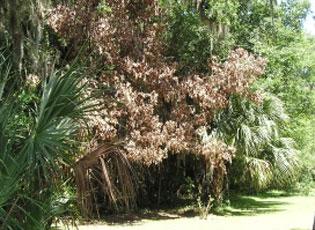Raffaelea lauricola sp. nov. T.C. Harr. Fraedrich & Aghayeva (Harrington et al. 2008)
Laurel wilt (LW)
Probably Asia (the disease vector, the redbay ambrosia beetle (Xyleborus glabratus), is native to Asia) (Harrington et al. 2008)
Redbay ambrosia beetle first discovered in 2002; disease first discovered in 2003 (Fraedrich et al. 2007)
Probably arrived with the redbay ambrosia beetle on imported wood packing materials (Harrington et al. 2008)
Fungal disease of redbay (Persea borbonia) and other trees in the laurel family (Lauraceae) (Harrington et al. 2008)
Southeastern U.S.

Laurel Bay Damage, host Redbay
James Johnson Georgia Forestry Commission
Find more images
Spotlights
Distribution / Maps / Survey Status
All Resources
Selected Resources
The section below contains highly relevant resources for this species, organized by source.
Partnership
State and Local Government
Fraedrich, S.W., T.C. Harrington, and R.J. Rabaglia. 2007. Laurel wilt: a new and devastating disease of redbay caused by a fungal symbiont of the exotic redbay ambrosia beetle. Newsletter of the Michigan Entomological Society 52(1-2):14-15.
Harrington, T.C., S.W. Fraedrich, and D.N. Aghayeva. 2008. Raffaelea lauricola, a new ambrosia beetle symbiont and pathogen on the Lauraceae. Mycotaxon 104:399-404.
